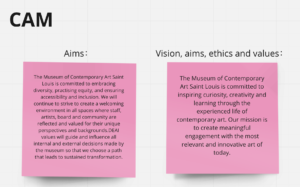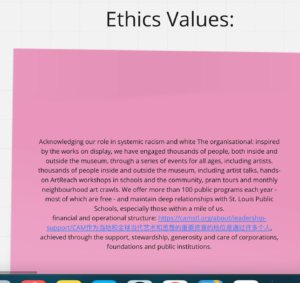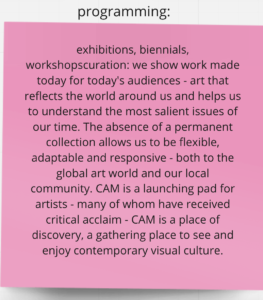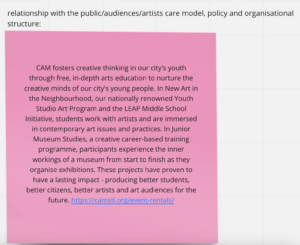Week2#Response of seminar
In group discussions, you will consider a range of example organisation’s vision, aims, ethics and values. You will also discuss their working practices and their local and global context (these examples are outlined below according to your Group). You will also consider how these commitments manifest through public programming, curation, curatorial themes, accessibility/availability of the space, financial structure, relationships with audiences, artists worked with, demonstrations of care, policies and organisational structure.
About the text Situating the Curatorial:
Our group’s reading text was Situating the Curatorial, where “curation” is centered on the connections between artworks and other materials, spaces, and specific display times. In discussing the emergence of the curatorial field, Beatrice von Bismarck emphasized the “constellation model” of “curation,” a dynamic constellation of fields in which various activities and public art have to be done. Rogoff refers to curated projects as “knowledge events,” environments in which different kinds of knowledge come together and test new things. The curated events involve epistemological processes and are demonstrative rather than representational, a distinction that Rogoff attributes to the visitors to the exhibition. Curating is a technical model that we know from art institutions and independent projects. On the other hand, ‘curation’ would be a more decentralized presence, designed to create friction and promote new ideas through processes of meaning and relationships between objects, people, places, ideas, and so on. Curating does not stop at the status.
In this article, there is an interesting term called the “Eros effect,” drawing on a 1989 article of the same name by researcher and activist George Katsiaficas, which argues that the emotional dimension of social movements is as important as their political dimension. Social movements have always been both, and the liberation struggle is as much an erotic act as it is a rational desire to escape structural and psychological barriers.
About the text The Curatorial Turn: From Practice to Discourse by Paul O’Neill:
Visuals, display, and narrative are at the heart of any exhibition, which remains the most privileged form of display art, and display can be understood as the heart of the exhibition. Contemporary curatorial discourse began to take shape in the 1990s, during what a generation of curators, Michael Brunson, called the ‘curatorial moment’, when curatorial knowledge was gradually becoming a mode of discourse with an unstable historical foundation.
To curate is to become the discourse, and the curator is willing to be the key subject and producer of this discourse himself. The time of the artist and the curator is separated, and for those who are unwilling to accept the regulations of the curatorial figure in a reconfigured field of cultural production, the critical response has been maintained at the level of an overly simplistic confrontation, and if it continues, the gap between curatorial criticism and the curatorially dominated discourse will only widen.
The exhibition involves the imposition of order on objects, bringing them into a particular space and into a particular set of relationships with each other. The ordering may conform to established conventions of classification and display, or it may challenge convention, and the exhibition requires visual attention.
It was once said that he had always thought of curators as facilitating artists, which meant that it had not previously occurred to him that curators could initiate exhibition concepts, find artists and research contexts, negotiate with galleries and publishers and, indeed, creatively shape themselves in their own right.
In exhibitions where curators have identified a theme or proposition, or simply use the work of others to illustrate it, and create works designed to anchor and limit the potential for interpretation, interest is rarely maintained for long. But if an exhibition is well thought out and makes a significant contribution to knowledge in a particular field, the workings of the voice can be complex. In effect, it will create a dialogue between the works on display and between the curator and the work. The multiple discourses in which this dialogue resonates help to enhance the quality of audience engagement.
Our group work:
We have sorted out the vision, objectives, ethics, and values, organizational, financial, and operational structures, and curatorial and thematic relationships with the public, audience, and artists into post-it notes on our miro board, and in group work, we can choose from examples such as the Centre for Contemporary Art Glasgow, The Silent Gallery, and As there were exactly 8 students in our group, we worked in groups. (As we had all studied before the class, we chose to work in pairs on one topic, with the group speaking in unison at the end and the other partners adding to it.) Tianxing Peng and I chose to use the Walker Arts Centre (Paul Chan) as an example for our study.
https://miro.com/app/board/uXjVPxB1tk0=/




These are our conclusions about CAM, which can be found in more detail in the Miro link above.
In the collision of the group discussions, we found that art has a public good to a certain extent, while basically understanding the position of the curator, the curator, and the thinking in conducting the process of arranging the artwork.




Recent comments